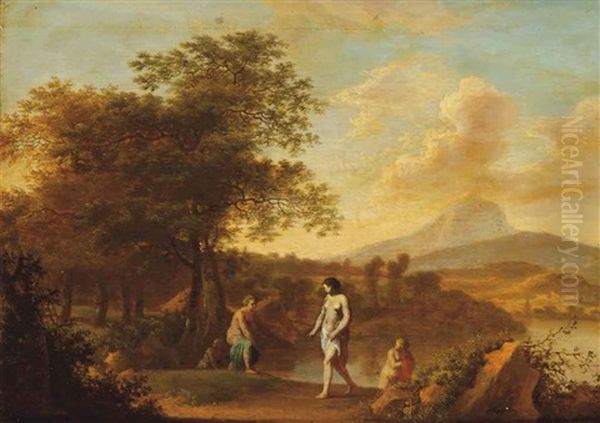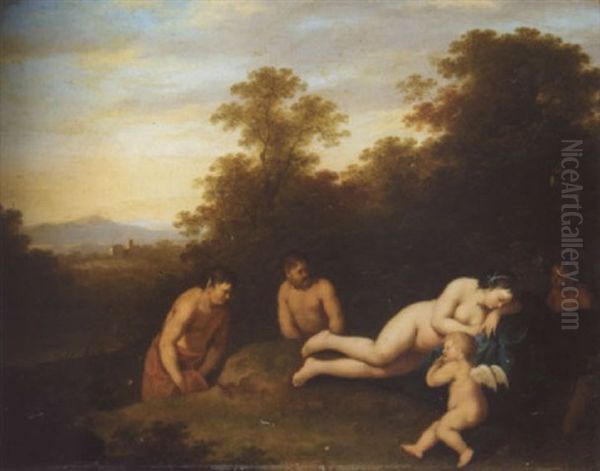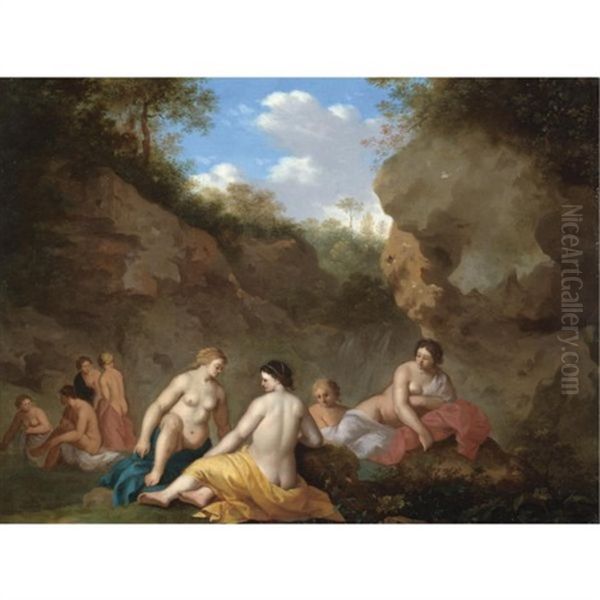Johan van Haensbergen, sometimes referred to as Jan van Haensbergen, stands as a notable figure within the rich tapestry of the Dutch Golden Age of painting. Active during the latter half of the 17th century, he navigated the vibrant art scenes of Utrecht and The Hague, leaving behind a legacy characterized by refined landscapes, mythological scenes, and particularly successful portraits. Born in 1642 and passing away in 1705, his life spanned a period of immense artistic innovation and production in the Netherlands. As a student of a prominent master and later an influential figure in artistic organizations, Van Haensbergen's career reflects both the continuity of tradition and the development of a personal style that earned him recognition among his contemporaries.
Early Life and Artistic Formation
The precise birthplace of Johan van Haensbergen remains slightly ambiguous, with historical sources suggesting either Utrecht or the town of Gorinchem (also known as Gorkum) as possibilities. Regardless of the exact location, his birth year is firmly established as 1642. His artistic journey began under the tutelage of one of the leading figures of the Dutch Italianate movement, Cornelis van Poelenburch (c. 1594–1667). This apprenticeship was crucial in shaping Van Haensbergen's early artistic sensibilities.
Cornelis van Poelenburch was renowned for his small-scale, highly polished landscapes depicting Arcadian scenes, often populated with mythological or biblical figures. Having spent significant time in Rome and Florence, Poelenburch brought back to Utrecht a style characterized by smooth surfaces, clear, warm light reminiscent of the Italian Campagna, and idealized figures. He became the leading figure of the first generation of Dutch Italianate painters based in Utrecht, influencing numerous pupils. Van Haensbergen was one of these students, absorbing the techniques and thematic preferences of his master.
The Influence of Poelenburch and the Italianate Style
The impact of Cornelis van Poelenburch is evident in Johan van Haensbergen's early works, particularly his landscapes and mythological compositions. Like his master, Van Haensbergen initially favored idyllic, Italianate settings, often featuring classical ruins or serene countryside bathed in a soft, luminous light. The meticulous finish and smooth application of paint, hallmarks of Poelenburch's style, can also be observed in Van Haensbergen's handling of these subjects.

The Dutch Italianate movement itself was a significant trend within the broader Dutch Golden Age. Artists like Poelenburch, Bartholomeus Breenbergh (a contemporary and sometimes rival of Poelenburch), Jan Both, Nicolaes Berchem, and Karel Dujardin traveled to Italy, drawn by its classical heritage and the quality of its light. They returned to the Netherlands to create works that combined Italian motifs and atmosphere with Dutch sensibilities, catering to a clientele fascinated by the classical world and the sunny south. Van Haensbergen operated within this tradition, contributing works that echoed the Arcadian visions popularized by his teacher and peers.
Developing an Independent Style: Landscapes and Mythology
While initially following closely in Poelenburch's footsteps, Johan van Haensbergen gradually developed his own nuances within the Italianate landscape genre. His works often feature mythological narratives, a popular subject choice inherited from his master. Themes involving nymphs, satyrs, and classical deities frequently appear in his oeuvre. Notable examples include paintings depicting the story of Diana and Actaeon and scenes of Nymphs Bathing or Bathing Women, subjects that allowed for the depiction of idealized female nudes within a classical landscape setting.
One of his recognized works in this vein is the Italian Landscape with Ruins, Shepherdess, and Nymphs. Described as a Baroque masterpiece, this painting showcases characteristics associated with the style: a sense of drama, potentially through lighting or composition, complex arrangement of figures and landscape elements, and a rich, though clear, color palette. While perhaps lacking the sheer atmospheric brilliance of masters like Claude Lorrain, whose idealized landscapes profoundly influenced the genre across Europe, Van Haensbergen demonstrated considerable skill in composing these intricate scenes. His works often possess a clarity and precision that distinguishes them, maintaining a refined finish throughout.
A Shift Towards Portraiture
Interestingly, historical accounts, including those by the early art historian Arnold Houbraken, suggest that Johan van Haensbergen later shifted his focus significantly towards portraiture. While he continued to produce landscapes and mythological scenes, he found considerable success and perhaps greater financial reward in painting portraits. This transition marks a departure from the primary focus of his teacher, Poelenburch, who was less known for portrait work.

Van Haensbergen gained particular acclaim for his portraits of women, especially young women. His style in this genre was noted for its delicacy and refinement. The provided source material mentions his use of "fine pastel techniques," suggesting a soft, subtle handling of flesh tones and fabrics, resulting in portraits that were lively, gentle, and flattering to the sitter. This skill in capturing likenesses with an elegant touch likely appealed to the affluent clientele of The Hague, where he was primarily active later in his career. His Portrait of a Young Woman serves as an example of his capabilities in this field, showcasing his ability to render features and textures with precision and sensitivity.
In the context of Dutch Golden Age portraiture, Van Haensbergen operated alongside giants like Rembrandt van Rijn and Frans Hals, though his style was distinct. While Rembrandt explored profound psychological depth and Hals captured fleeting moments with vigorous brushwork, Van Haensbergen seems to have aimed for a more polished, courtly elegance, perhaps closer in spirit, though different in technique, to artists like Gerard ter Borch or Michiel van Mierevelt, the latter being a dominant portraitist in The Hague earlier in the century.
Career in The Hague: Guilds and Academies
Johan van Haensbergen's professional life became increasingly centered on The Hague, a city that served as the administrative heart of the Dutch Republic and boasted a sophisticated art market. His standing within the artistic community there is evidenced by the important positions he held. He was associated with the local Guild of Saint Luke, the traditional organization for painters and craftsmen, possibly holding roles like 'hoofdman' (chief or dean) as mentioned in some sources, although this might also refer to his Utrecht connections earlier.
More significantly, Van Haensbergen became a leading figure in the Confrerie Pictura. This association was founded in The Hague in 1656 by a group of artists, including Adriaen Hanneman, who sought to elevate the status of painting above that of a mere craft, breaking away from the more diverse membership of the traditional Guild of Saint Luke. The Confrerie aimed to establish painting as a liberal art and fostered a more academic approach. Van Haensbergen served as 'hoofdman' (Chief) of the Confrerie Pictura, a testament to the respect he commanded among his peers.
Furthermore, he held the position of Director of the Haagsche Teekenacademie (The Hague Drawing Academy), an institution closely associated with the Confrerie Pictura, dedicated to the formal training of artists. Holding these leadership roles indicates that Van Haensbergen was not merely a practicing artist but also an influential administrator and organizer within The Hague's art world, contributing to the structure and prestige of the artistic profession in the city. His involvement underscores the increasing professionalization and academic aspirations of artists during this period.
Artistic Context: The Dutch Golden Age

To fully appreciate Johan van Haensbergen's contribution, it is essential to place him within the broader context of the Dutch Golden Age. The 17th century witnessed an unprecedented flourishing of arts and sciences in the Dutch Republic. Economic prosperity fueled a burgeoning art market, with demand extending beyond the church and aristocracy to include wealthy merchants, burghers, and civic institutions. This led to a high degree of specialization among painters.
While Van Haensbergen practiced in the Italianate landscape and portrait genres, other artists achieved fame in distinct fields. Johannes Vermeer captured serene domestic interiors with unparalleled mastery of light and composition. Jacob van Ruisdael became the preeminent master of naturalistic Dutch landscapes, often imbued with dramatic or melancholic undertones. Jan Steen specialized in lively, often humorous genre scenes depicting everyday life. Frans Hals revolutionized portraiture with his dynamic brushwork and ability to capture personality.
Other notable contemporaries included Gerard ter Borch, known for his exquisite rendering of textures in elegant interior scenes; Pieter de Hooch and Gabriel Metsu, also masters of genre painting; Adriaen van Ostade, depicting peasant life; and Philips Wouwerman, famed for his scenes involving horses, particularly battles and hunts. Even within the Italianate sphere, artists like Adam Pynacker developed distinct styles. Van Haensbergen's work, therefore, represents specific currents within this incredibly diverse and prolific artistic environment. His adherence to the refined Italianate tradition, combined with his successful foray into elegant portraiture, carved out a specific niche for him.
Notable Works and Collections
Several key works help define Johan van Haensbergen's artistic output. His mythological landscapes, such as Diana and Actaeon and Nymphs Bathing, are representative of his connection to the Poelenburch school and the broader Italianate tradition. These works often feature carefully rendered figures set against idealized natural backdrops, sometimes incorporating classical ruins. The Mauritshuis Royal Picture Gallery in The Hague holds examples of his work, including versions of Diana and Actaeon and Bathing Women, confirming the presence of his art in major Dutch collections.
His Italian Landscape with Ruins, Shepherdess, and Nymphs stands out as a particularly ambitious composition, noted for its Baroque qualities – dynamism, complexity, and perhaps heightened emotional content within the classical framework. In portraiture, works like Portrait of a Young Woman demonstrate his skill in capturing likenesses with a delicate and appealing finish, explaining his popularity in this genre.
The fact that Van Haensbergen's own collection included works by his teacher, Cornelis van Poelenburch, as mentioned in the source material, is also noteworthy. This practice was common among artists and collectors of the time and indicates his continued respect for his master and his engagement with the art market not just as a producer but also as a connoisseur. His works are found today in various museums and private collections, primarily in the Netherlands and surrounding regions.
Legacy and Assessment
Johan van Haensbergen died in The Hague on January 10, 1705, and was buried there shortly after. He lived to the age of 63, leaving behind a body of work that reflects the artistic trends and standards of his time. While perhaps not reaching the towering heights of fame occupied by Rembrandt or Vermeer, Van Haensbergen was a highly skilled and respected painter who made significant contributions in his chosen fields.
His primary legacy lies in his role as a competent follower and adapter of Cornelis van Poelenburch's influential Italianate style, producing refined landscapes and mythological scenes. He successfully transitioned this skill set into the lucrative field of portraiture, where he developed a reputation for elegant and sensitive depictions, particularly of female sitters. Furthermore, his active involvement and leadership within The Hague's Confrerie Pictura and Drawing Academy highlight his importance as a figure who contributed to the institutional framework and professional standing of artists in the Dutch Republic.
He represents a type of successful Golden Age master who, while perhaps overshadowed in modern estimation by the period's absolute geniuses, enjoyed considerable success and influence during his lifetime. His work provides valuable insight into the continuation of the Italianate tradition in the later 17th century and the demand for polished portraiture among the Dutch elite.
Conclusion
Johan van Haensbergen (1642–1705) remains a significant painter of the Dutch Golden Age, bridging the gap between the idealized landscapes of the Italianate tradition, learned from his master Cornelis van Poelenburch, and the demands of the portrait market in The Hague. His meticulously finished mythological scenes and his delicate, successful portraits earned him contemporary acclaim. Beyond his artistic output, his leadership roles in the Confrerie Pictura and the Haagsche Teekenacademie underscore his respected position within the professional art world of his time. As both an artist and an administrator, Van Haensbergen played a distinct role in the rich and complex art scene of the 17th-century Netherlands. His works continue to be appreciated for their refinement, clarity, and embodiment of the aesthetic values prevalent during the later stages of the Dutch Golden Age.